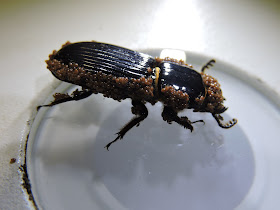Odontotaenius disjunctus is a common but fascinating Passalid beetle that goes by numerous common names: Bess Beetle, Bess Bug, Betsy Beetle, Horned Passalus Beetle, Patent-leather Beetle, Jerusalem Beetle, Peg Beetle, and Horn Beetle. They live in small family groups in decaying logs of deciduous trees, feeding on the rotten wood and are unique in a variety of ways.
Bess Bugs are one of the few beetles that show social behavior for instance. Adults communicate with each other as well as their young. They also not only feed their own young, but sometimes those of others that live in their log. In fact, the young (grubs) are unable to feed until they are given partially chewed wood and even feces by the adults. Betsy Beetles will care for their grubs in this manner for several months, also supplying the young with the microorganisms in their guts they need to digest wood in this way.
Here's a short clip of the grubs: https://www.youtube.com/watch?v=o4VpaY5rvCU&t=2s
Adults are able to communicate with each other by rubbing their wings against their abdomens, being able to stridulate audibly. The "Bess" name is believed derived from "baiser" meaning to kiss from this sound. A neat naturalist trick is to blow lightly on them and then hold them up for people to hear. The grubs are able to stridulate as well, having modified their last pair of reduced legs in order to be able to do so. This gives the larvae the appearance of only having 4 legs and makes their identification somewhat easier. Scientists have been able to discern 17 different sound signals these beetles make. This may be the most complex communication of any insect studied so far.
Here's a look at a young one, a grub:
Betsy Beetles have other unusual traits. While able to fly, they almost never do. They seem to have a nuptial flight to disperse, but then may not ever fly during their lives again. Those that have just completed metamorphosis are a red color for up to several months before turning into a shiny black beetle. These newly metamorphosed beetles are called "teneral" beetles, feeding their younger siblings. These insects are not harmful or pests since they only eat decaying wood, conducting a valuable service in breaking down and recycling fallen trees.
Black Patent Leather Beetles are often hosts to several species of tiny mites. These mites are not supposed to really harm the beetles, but can sometimes be found in great numbers, often concentrating themselves along the joints in the shell.
A Betsy Beetle covered in mites.
Bess Beetles can be active and found all year inhabiting rotten logs. I found the group pictured in late December, a nice surprise on a cold day. After warming them up by gently blowing on them, they sounded off for me before returning to their job of decomposers in the woods.
 |
| A grub with its 4-legged appearance. |




No comments:
Post a Comment